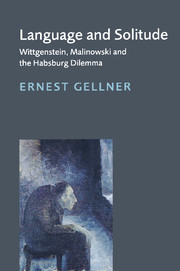Book contents
- Frontmatter
- Contents
- Preface
- Foreword
- Part I The Habsburg dilemma
- Part II Wittgenstein
- 10 The loneliness of the long-distance empiricist
- 11 The poem to solitude, or: confessions of a transcendental ego who is also a Viennese Jew
- 12 Ego and language
- 13 The world as solitary vice
- 14 The mystical
- 15 The central proposition of the Tractatus: world without culture
- 16 Wittgenstein mark 2
- 17 Tertium non datur
- 18 Joint escape
- 19 Janik and Toulmin: a critique
- 20 The case of the disappearing self
- 21 Pariah communalism
- 22 Iron cage Kafka-style
- Part III Malinowski
- Part IV Influences
- Part V Conclusions
- General bibliography
- Bibliographies of Ernest Gellner's writings on Wittgenstein, Malinowski, and nationalism
- Index
22 - Iron cage Kafka-style
Published online by Cambridge University Press: 05 March 2010
- Frontmatter
- Contents
- Preface
- Foreword
- Part I The Habsburg dilemma
- Part II Wittgenstein
- 10 The loneliness of the long-distance empiricist
- 11 The poem to solitude, or: confessions of a transcendental ego who is also a Viennese Jew
- 12 Ego and language
- 13 The world as solitary vice
- 14 The mystical
- 15 The central proposition of the Tractatus: world without culture
- 16 Wittgenstein mark 2
- 17 Tertium non datur
- 18 Joint escape
- 19 Janik and Toulmin: a critique
- 20 The case of the disappearing self
- 21 Pariah communalism
- 22 Iron cage Kafka-style
- Part III Malinowski
- Part IV Influences
- Part V Conclusions
- General bibliography
- Bibliographies of Ernest Gellner's writings on Wittgenstein, Malinowski, and nationalism
- Index
Summary
Wittgenstein's early vision is indeed one further working out of what may be called Descartes' problem: what is the world like, if the individual is to construct it himself, relying exclusively on elements he has himself assembled and tested? As Wittgenstein himself very aptly put it, in answer to this question, solipsism and realism converge, the world is the self and the self is the world. No transcendence is conceivable.
Given that there have been so many exercises in answering this question, just what is it that makes Wittgenstein's own little attempt of any interest? What is different about it? There are two things. One is the distinctive literary style: this unquestionably belongs to fin-de-siècle modernism. One might say that the other participants in the great epistemological tradition of Western philosophy worked in that field in order to explore the limits of human knowledge. That was their principal aim, and if they were a little unhappy about what they found – Hume and Kant certainly had their uneasy moments – that was the byproduct of their endeavour, not its objective. With Wittgenstein, one is not quite so sure. When he constructs that icy silent world with its pointless and disconnected facts, it is of course partly because his premises dictate the conclusions he reaches … partly. Yet, he clearly gets a certain kick out of being the messenger of doom, and makes sure he rams home the message by every literary device at his disposal and he is no mean writer. There have seldom been such literary fireworks in philosophy.
- Type
- Chapter
- Information
- Language and SolitudeWittgenstein, Malinowski and the Habsburg Dilemma, pp. 107 - 110Publisher: Cambridge University PressPrint publication year: 1998



